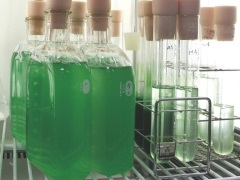Features
Growing fat algae
Date: 2018-08-23 13:18:02.0
Author: Jon Evans

Growing Cyanidioschyzon merolae cultures in
the laboratory.
Photo: Sousuke Imamura.
The commercial development of algal biodiesel is being hampered by an annoying catch-22. This is that microalgae generate lipids most abundantly when they are stressed in some way, meaning deprived of essential nutrients such as nitrogen or phosphorus, because then they direct their carbon resources to creating lipids rather than proteins or DNA. But algae don’t grow when they’re stressed, exactly because they don’t produce proteins or DNA, which ruins the economics of the whole process.
Commercial production of algal biodiesel would get a real boost from the development of strains of algae that can produce abundant lipids while still growing normally. So several research groups are searching for the genes and proteins involved in the stress-induced increase in lipid production, in order to find ways to induce the increase without the stress. And they are beginning to have some success.
Back in 2015, a team of US scientists found a transcription factor, a protein that controls the expression of several genes, that seemed to be involved in the stress response of the model algae Chlamydomonas reinhardtii (see Lipid production without the stress). Overexpressing this transcription factor increased lipid production even when the algae wasn’t stressed in any way.
Then last year, a team from the US biotechnology company Synthetic Genomics, led by Eric Moellering, identified a transcription factor involved in the stress response of a species of marine algae called Nannochloropsis gaditana. In this case, a lack of nutrients seemed to switch this transcription factor off, directing carbon resources away from protein production and towards lipid production.
Normally, N. gaditana uses around 40% of its carbon resources for producing proteins and around 20% for producing lipids, with the rest used for producing carbohydrates. When Moellering and his team used the genetic editing technique known as CRISPR-Cas9 to switch off the gene for the identified transcription factor, they found that the resultant strain now used 55% of its carbon for producing lipids and just 5% for producing proteins. However, as they report in a paper in Nature Biotechnology, the downside was that the algae stopped growing, which is hardly surprising given the lack of protein.
So Moellering and his team decided to try reducing the activity of this transcription factor, rather than switching it off completely. They did this by using RNA interference to block some of the messenger RNA coding for the transcription factor, creating a strain that used 40% of the carbon for producing lipids and 20% for producing protein. This strain thus produced double the usual amount of lipid, while growing normally.
Now, in a paper in Scientific Reports, Sousuke Imamura and his colleagues at the Tokyo Institute of Technology in Japan report finding a gene that plays a critical role in the stress response of the model algae Cyanidioschyzon merolae. This gene is one of two that codes for an enzyme called glycerol-3-phosphate acyltransferase. In a previous study, Imamura and his colleagues had shown that both these genes are upregulated when C. merolae is exposed to the nitrogen-deprived conditions that promote lipid production, suggesting they may be involved in the process.
This led Imamura and his colleagues to try overexpressing each of these genes. When they overexpressed the gene known as CmGPAT1, the resultant strain produced 56 times more lipid than usual while still growing normally, making it even more productive than a natural strain exposed to nitrogen-deprived conditions. In contrast, overexpressing the sister gene CmGPAT2 had no such effect.
Imamura and his colleagues are unsure why the two genes behave so differently when they code for the same enzyme. But they are now trying to find the transcription factor that regulates CmGPAT1, to see whether that offers an even less stressful way to enhance lipid production.
The views represented here are solely those of the author and do not necessarily represent those of John Wiley and Sons, Ltd. or of the SCI.
Displaying 2 keywords used to tag this article:
- Jules Audemars-Australia Best Quali
- DG6582 Mens Moncler Down Jackets Gr
